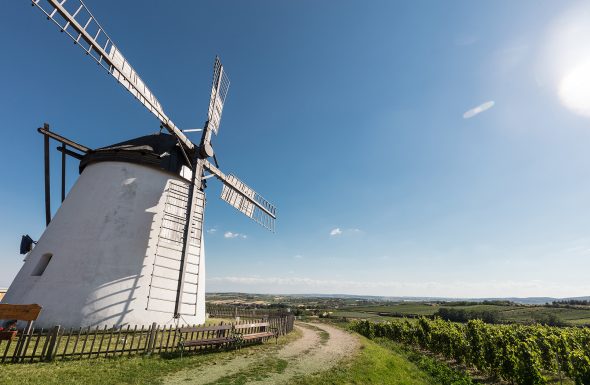Throughout the Weinviertel, Austria‘s largest winemaking area, vintners are pleased and quite satisfied with the 2019 vintage in terms of both quality and quantity, the latter of which corresponds to a solid average yield. The weather last year did not create any serious challenges for winemakers, and the results in their cellars have been sensational.
Simply due to the large size of the Weinviertel, weather conditions can vary dramatically between the eastern and western sections. This was not the case in 2019, although it was a year of temperature records. It was the third-warmest of the last 252 years as measured by average annual temperature, according to Austria’s ZAMG.* Although the annual precipitation in eastern Austria was in general 25 to 40 percent lower than the long-term average, the Weinviertel benefitted from a better distribution of rainfall and greater amounts than in the previous years.
The year’s bud break started early in the spring and the vegetation developed quite quickly due to warm temperatures, after increased rainfall during the winter months had soaked the ground to provide a good basis of soil moisture. At the end of April and beginning of May, cool temperatures and rain slowed the rapid growth to normal, and at the same time provided a good level of humidity just when the vegetation needed it most. As a consequence, flowering took place at the “traditional“ time – e.g. at the end of June in the eastern Weinviertel, which is most influenced by the warm Pannonian climate from the east.
From the end of May until mid-July, there was a period of consistently good weather with occasional very high temperatures. Luckily enough the rain came – often as thunderstorms – when winemakers found it most necessary, e.g. in mid-July in the eastern Weinviertel. It rained sufficiently even around Retz, historically the driest area of the Weinviertel, and in the Gänserndorf area, in contrast to some years before when these areas suffered from drought. Along the western border, the Weinviertel benefited as always from the neighbouring cool and rainy Waldviertel: thunderstorms coming from the west tend to “spill over“ the Manhartsberg, the mountain on the border between these two regions.
The vegetation grew rampantly compared to the significantly drier years previous, so canopy management was crucial to ventilate the grapes and to provide shade. Hailstorms did not cause problems this year, and when they did occur they affected only small, limited areas. More and more often netting is being used to protect the grapes against the “foraging missions“ of starlings, a growing problem in recent years. These nets also help to ease the damage caused by hailstorms.
Starting at the end of August, day-night temperature variations started to be significant, supporting the flavour profile and retaining acidity in the grapes. The weather in August was again dry until the harvest started at the “normal” time in mid-September. Harvesting took place into October during a period of mostly dry weather, interrupted by occasional short rainshowers.
Winemakers all over the Weinviertel are very satisfied with the quality of the grapes they harvested in 2019 and describe the resulting wines as “extremely pleasing”, “highly satisfying” and “spectacularly good”. These wines are very well balanced with beautifully clear fruit flavours, are lively and very accessible, but not lacking in depth or structure. In particular the Grüner Veltliner, the most important variety in the Weinviertel, is excellent this year as it grew under ideal conditions everywhere in the area. Other varietals also shine with distinct typicities and precise fruit flavours.
Fans of the Weinviertel can expect a clearly excellent 2019 vintage.
Photo credits: (reprint free of charge for editorial use) © Regional Wine Committee Weinviertel/Anna Stöcher
(Sources: *Zentralanstalt für Meteorologie und Geodynamik, ZAMG; statements from winemakers throughout the area)

